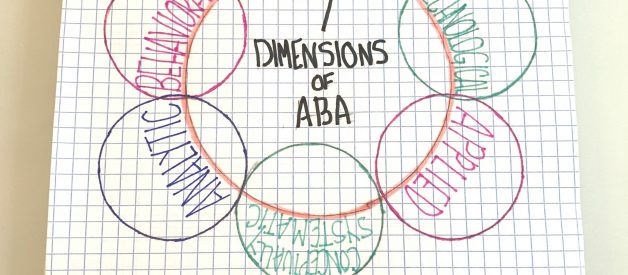This week we are taking a deeper look into the field of Applied Behavior Analysis, otherwise referred to as ?ABA.? ABA) is based on evidenced-based scientific methods using the 7 dimensions (Baer, Wolf, Risley, 1968) that all practitioners should follow. It is important that an individual?s treatment plan has goals following these 7 dimensions: 1) Generality, 2) Effective, 3) Technological, 4) Applied, 5) Conceptually Systematic, 6) Analytic, 7) Behavioral. The ultimate goal of a Behavior Analyst is to bring about meaningful change to their children and families and for that change to occur in situations other than where it was explicitly taught, (i.e., community, school, with family members, etc.). That meaningful change can happen when Behavior Analysts are using the 7 dimensions of ABA #getacab.
Below we are going to focus on each one of the aforementioned seven dimensions in further detail with the goal of helping grow your understanding in each.

Generality
When a behavior is targeted for change, that change should not just be programmed to occur in the moment, or for a short time thereafter. The behavior change, meaning the skills gained within treatment, should stand the test of time. Moreover, it should maintain across different people and environments well after treatment has ended.
Often times ABA is conducted in a sterile environment, or more clinical type setting. Although programming is initially occurring in this setting, the treatment should be designed in such a way that reflects the individual?s natural environment. By doing so, we help ensure the behavior generalizes across different environments outside of treatment, and that it will maintain across time. It is best practice to have consistent staff during your child?s treatment, but the child should have access to practice learned skills with other children and staff. A treatment is not considered effective or successful until generality is achieved.
Effective
Goals should reflect and be relevant to the client and the culture of their community, but just as important- the interventions being used must be effective. Important questions to ask are: ?Is the intervention working? ?Am I seeing the data going in the desired direction?? These questions can be answered by frequent progress monitoring of data collection and observing the interventions being utilized.
Technological
An intervention should be written in a way where it describes all of the components clearly and detailed enough for anyone else to replicate it. To make this possible, all of the techniques that comprise an intervention should be fully identified and described. As an example, think about your favorite Pinterest recipe for baking a cake- it?s well written, easy to understand and executable. So much so that even my husband can do it!. Applying behavioral analytic interventions to individuals is clearly more complex, however, it should follow the same rules. Let?s pretend the intervention outlined is difficult to understand or not clearly written; the chances that everyone on the treatment team are implementing treatment in the same way is low. When a behavior intervention is technological, intervention is easy to replicate and treatment integrity is high.
Applied
The term applied refers to implementing ABA interventions in society, after it?s gone through research in a laboratory. Behavior Analyst?s must focus on these implementation principles of ABA to change socially significant behaviors. The particular treatment goals decided upon as a prioritizing focus is based on its importance to the individual, and individuals family. Each individual?s socially significant behaviors are individual to them, and are the skills that will allow this individual to more easily, and successfully, function within their environment. For intervention to be socially valid, it must produce a significant meaningful change that maintains over time.
For example, if a child is engaging in tantrum behaviors because they are not able to effectively communicate their wants and needs, what would be a meaningful behavior to target? Teaching the child how to effectively communicate their wants and needs would be a socially valid goal. It would immediately affect the client?s everyday life, as well as the lives of those who interact with the child on a daily basis (family members, teachers, friends). When considering treatment interventions, the team must always consider how immediately important the targeted behavior change will be to the client.
Conceptually systematic
To say that an intervention is conceptually systematic, says that the intervention is research- based and represents principles of applied behavior analysis. An important question to ask: ?Is this intervention consistent with principals that have determined to be effective as defined in the research??
Analytic
Being analytical means looking at the data to make data-based decisions, which means data must be collected on interventions. When looking at the data, if an intervention being used is not showing a change/ increase in the desired behavior then a change is warranted. Once the intervention is modified and data shows an increase in desired direction, then we can prove a reliable relationship between our intervention and the increase in positive behavior. This addresses the issue of believability: is the intervention being used and data showing the change be sufficient enough to prove a reliable functional relationship?
Behavioral
Behavior must be observable and measurable in order for it to be changed. If we can observe and see behavior, we can measure it with data, and then we can change it (Gilmore, 2019). When we say the term ?behavior? it doesn?t just have to mean ?bad? behavior, but behavior can also be appropriate or desirable behavior. Behavior Analysts want to increase some behaviors and decrease others. It is also important to describe ?behavior change? in terms of how the child?s life is changed, rather than just their behavior.
Understanding the 7 dimensions of Applied Behavior Analysis and how it is implemented within your son or daughter?s goals and programming will help create more meaningful changes and produce a greater impact.
Citation
Baer, D. M., Wolf, M. M., & Risley, T. R. (1968). Some current dimensions of applied behavior analysis1. Journal of Applied Behavior Analysis, 1(1), 91?97. doi:10.1901/jaba.1968.1?91
Cooper, J. O., Heron, T. E., & Heward, W. L. (2007). Applied behavior analysis(2nd ed.). Columbus, OH: Merrill Prentice Hall
Gilmore, Heather. ?Seven Dimensions of ABA (Applied Behavior Analysis): Changing Human Behavior the Scientific Way.? Reflections from a Children?s Therapist, 30 Jan. 2019, pro.psychcentral.com/child-therapist/2015/07/seven-dimensions-of-aba-applied-behavior-analysis-changing-human-behavior-the-scientific-way/.


